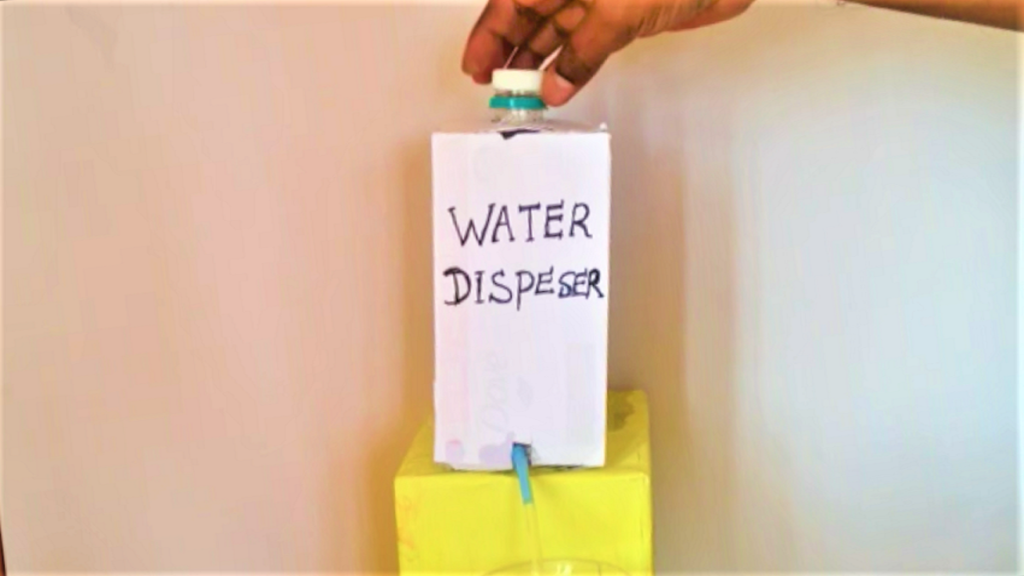
1. Question: What inspired the creation of this water dispenser model?
Answer: The inspiration behind this water dispenser model is to explore an eco-friendly and energy-efficient approach to providing clean and safe drinking water.
2. Question: How does the water dispenser work?
Answer: The water dispenser uses a simple gravity-fed system. When a cup is placed under the dispenser, a valve opens to allow water to flow from the container through a filtration system and into the cup.

3. Question: What type of filtration system does the water dispenser use?
Answer: The water dispenser employs a multi-stage filtration system that includes activated carbon and a microfiltration membrane to remove impurities and ensure clean drinking water.
4. Question: How is the water kept cool in the dispenser?
Answer: The water dispenser incorporates a cooling mechanism using a thermoelectric cooler or a refrigeration unit, ensuring that the water is maintained at a refreshing temperature.
5. Question: Can this water dispenser be used in areas with limited access to electricity?
Answer: Yes, the model is designed to be energy-efficient, and it can operate without electricity, making it suitable for areas with power constraints.
6. Question: What materials are used to build the water dispenser?
Answer: The water dispenser is constructed using food-grade, durable materials such as BPA-free plastic for the container and stainless steel for critical components.
7. Question: How is the dispenser cleaned?
Answer: The design allows for easy disassembly, and components can be cleaned using mild soap and water. The filtration system is replaceable, ensuring ongoing cleanliness.
8. Question: Is the water dispenser suitable for both home and commercial use?
Answer: Yes, the model is versatile and can be scaled for both household and commercial applications, offering a sustainable and cost-effective solution.

9. Question: What safety features does the water dispenser incorporate?
Answer: The water dispenser includes safety features such as a child-lock system to prevent accidental dispensing and a leak-proof design to avoid spillage.
10. Question: How is the water quality ensured?
Answer: The water quality is maintained through the filtration system, which removes contaminants, odors, and impurities, ensuring that the dispensed water is clean and safe for consumption.
11. Question: Can the dispenser accommodate different water sources?
Answer: Yes, the water dispenser is designed to work with various water sources, adapting to different water qualities and ensuring consistent filtration performance.
12. Question: How does the dispenser handle water pressure?
Answer: The dispenser is designed to handle varying water pressures, and the valve system is calibrated to dispense water efficiently under different conditions.
13. Question: What are the environmental benefits of this water dispenser?
Answer: The water dispenser promotes environmental sustainability by reducing the need for single-use plastic bottles and encouraging the use of tap water.
14. Question: Can the dispenser accommodate hot water?
Answer: Some models can accommodate hot water as they integrate a heating element, providing users with the option of both hot and cold water.

15. Question: How does the water dispenser contribute to water conservation?
Answer: By promoting the use of tap water and eliminating the need for bottled water, the dispenser contributes to water conservation efforts.
16. Question: Can the filtration system be customized for specific water conditions?
Answer: Yes, the filtration system can be customized based on the specific water conditions of the region, ensuring optimal performance.
17. Question: How is the dispenser refilled?
Answer: The dispenser is refilled by opening the top lid and pouring water into the main container, allowing for easy and convenient replenishment.
18. Question: Does the dispenser have a self-cleaning mechanism?
Answer: Some models may incorporate a self-cleaning feature using UV-C light or other technologies to disinfect internal components periodically.
19. Question: Can the dispenser be connected to a water supply line?
Answer: Yes, some models can be directly connected to a water supply line for continuous dispensing without the need for manual refilling.
20. Question: How is the water dispenser adapted for regions with limited access to clean water?
Answer: The model is designed with a robust filtration system that can effectively purify water from various sources, making it suitable for regions with limited access to clean water.
21. Question: What maintenance is required for the water dispenser?
Answer: Regular maintenance involves cleaning and replacing the filtration system as needed, ensuring consistent performance and water quality.
22. Question: How does the dispenser manage water temperature in changing environments?
Answer: The cooling or heating mechanisms are designed to adapt to ambient temperatures, maintaining the desired water temperature in different environmental conditions.
23. Question: Can the dispenser be customized for specific user preferences?
Answer: Yes, certain features of the dispenser, such as water temperature and dispensing speed, can be customizable based on user preferences.
24. Question: How does the dispenser handle power outages?
Answer: The dispenser is designed to retain its cooling or heating capabilities for a certain period during a power outage, ensuring continued functionality.
25. Question: What is the cost-effectiveness of using this water dispenser compared to traditional methods?
Answer: While the initial investment may be higher, the long-term cost-effectiveness stems from reduced reliance on bottled water and the eco-friendly design, making it a sustainable and economical solution.

